A New York artist by way of New Orleans, Rashaad Newsome has his hands deep in many art mediums: photography, performance art, sculpture, musical composition, and collage. Lounging in his studio clutching a huge mug of coffee, he makes a statement that initially flies under the radar but soon reveals itself as a core value in his entire artistic pursuit: “There is no longer culturally specific material.” Though the tagline of fusing high and low culture has been overused and hung out to dry for years, Rashaad can be credited with giving it a fresh take through his work.
His soft-spoken demeanor belies the loud visuals that hurl themselves at his audiences from the depths of the collage work he presents throughout a tour of his studio. Picture 16th century royal coats-of-arms, and then replace with traditional motifs of unicorns, lions, crowns, with Lamborghinis, Louis Vuitton logos, diamond-plated Rolex watches, and sizeable thong-clad asses cropped out of 90’s hip-hop music videos. Rashaad makes bold statements, invading fine art with ‘lower culture’ to blur lines and shatter all traces of artistic elitism. Not fully comfortable being in the spotlight, and at the opposite end of the camera lens, by the completion of the visit the conversation had surpassed initial discussions about documenting the perils of online dating. His studio in Long Island City, Queens is on a quiet street corner and boasts a convenient distance to the subway and affordable price tag that only comes by leaving the confines of Manhattan.
This portrait was produced in collaboration with MAKER Magazine.




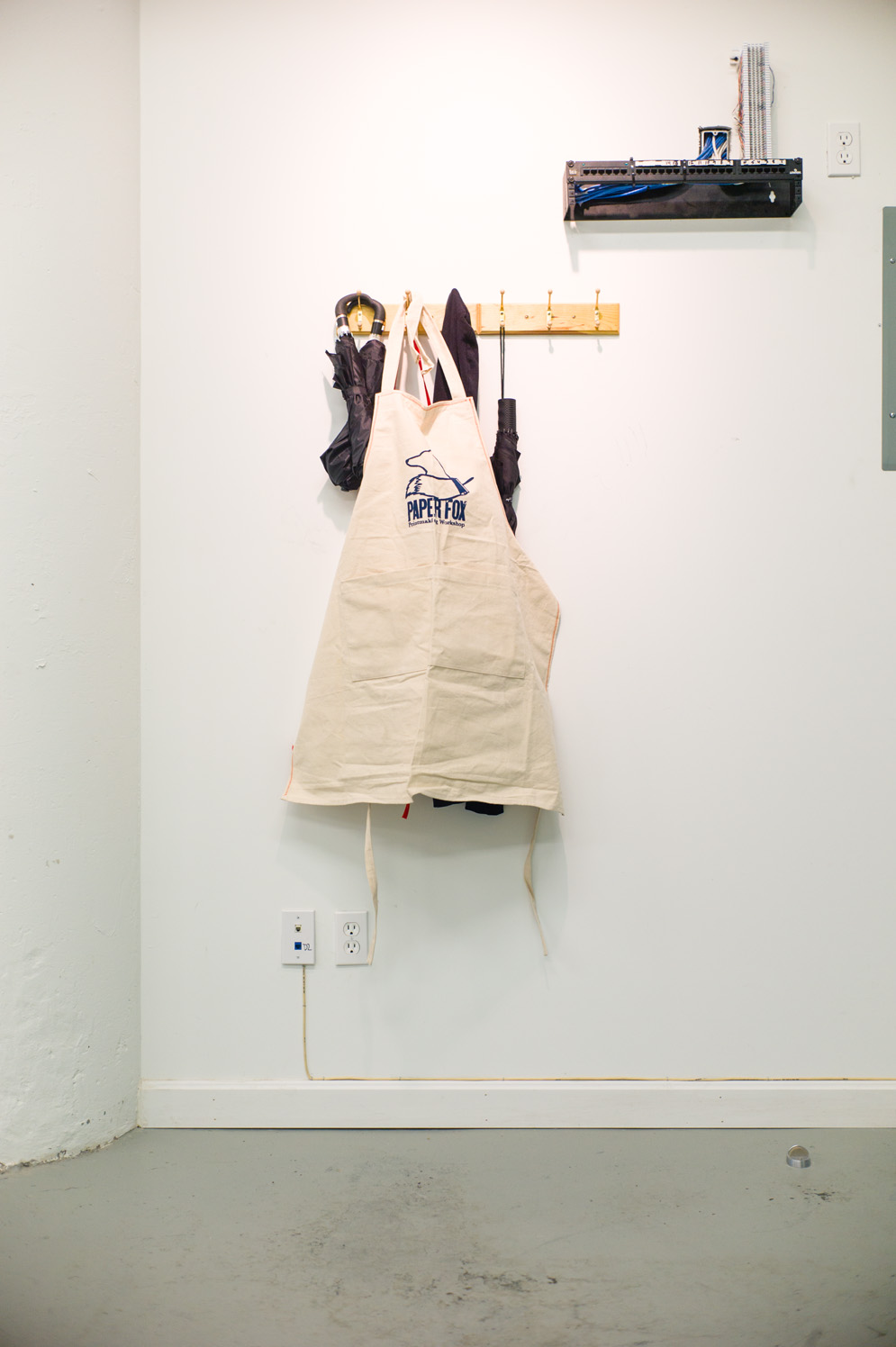









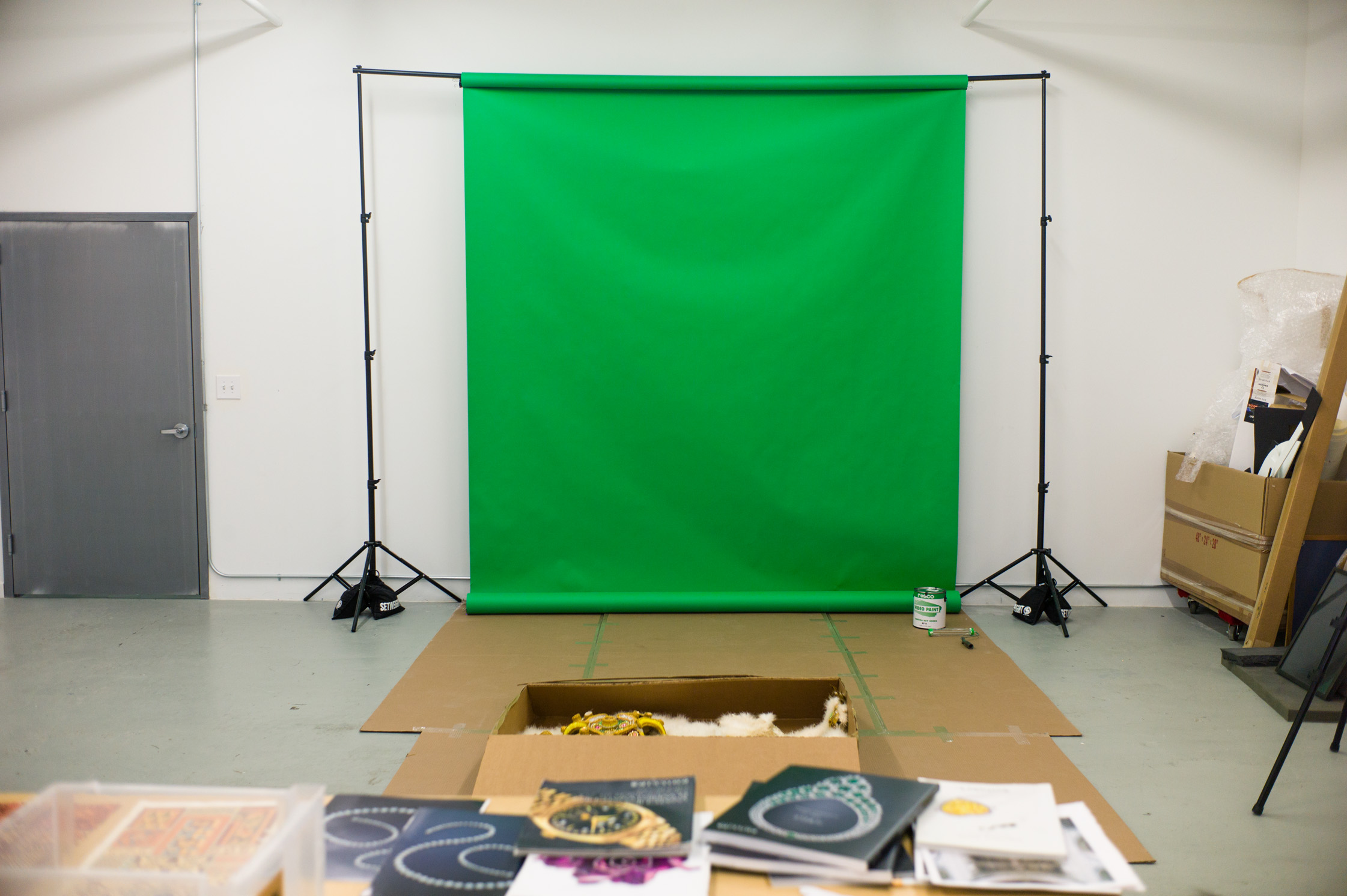




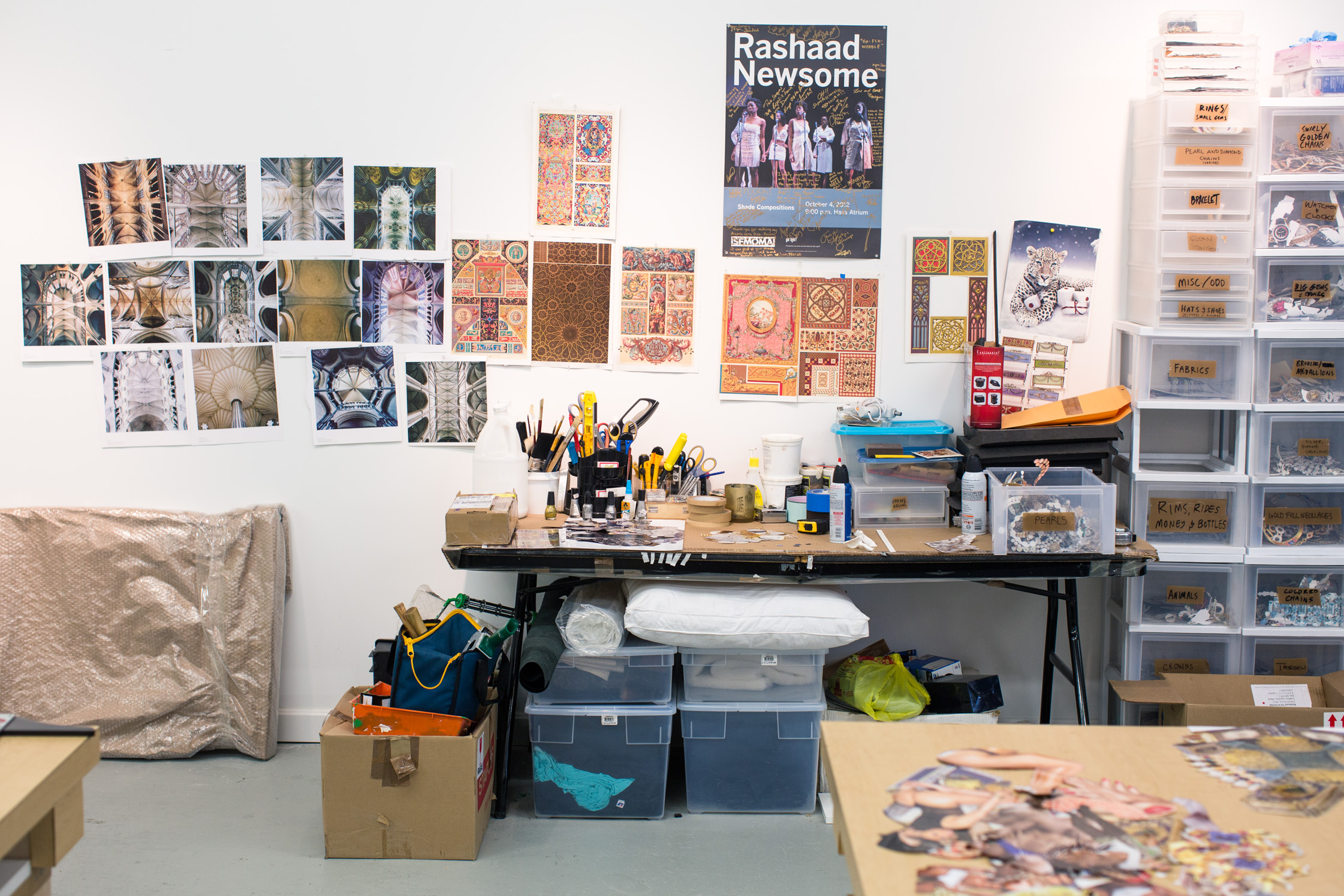


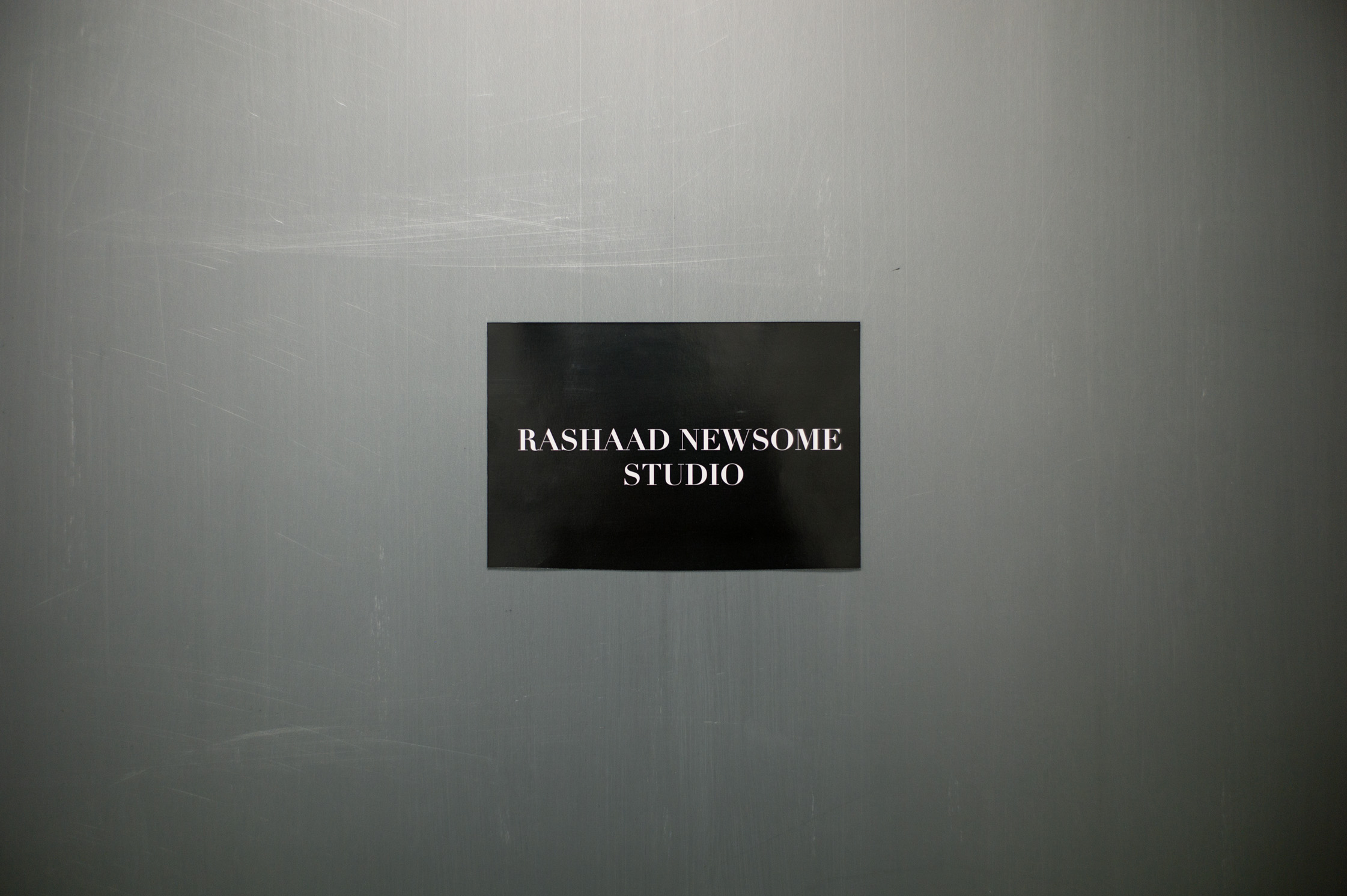



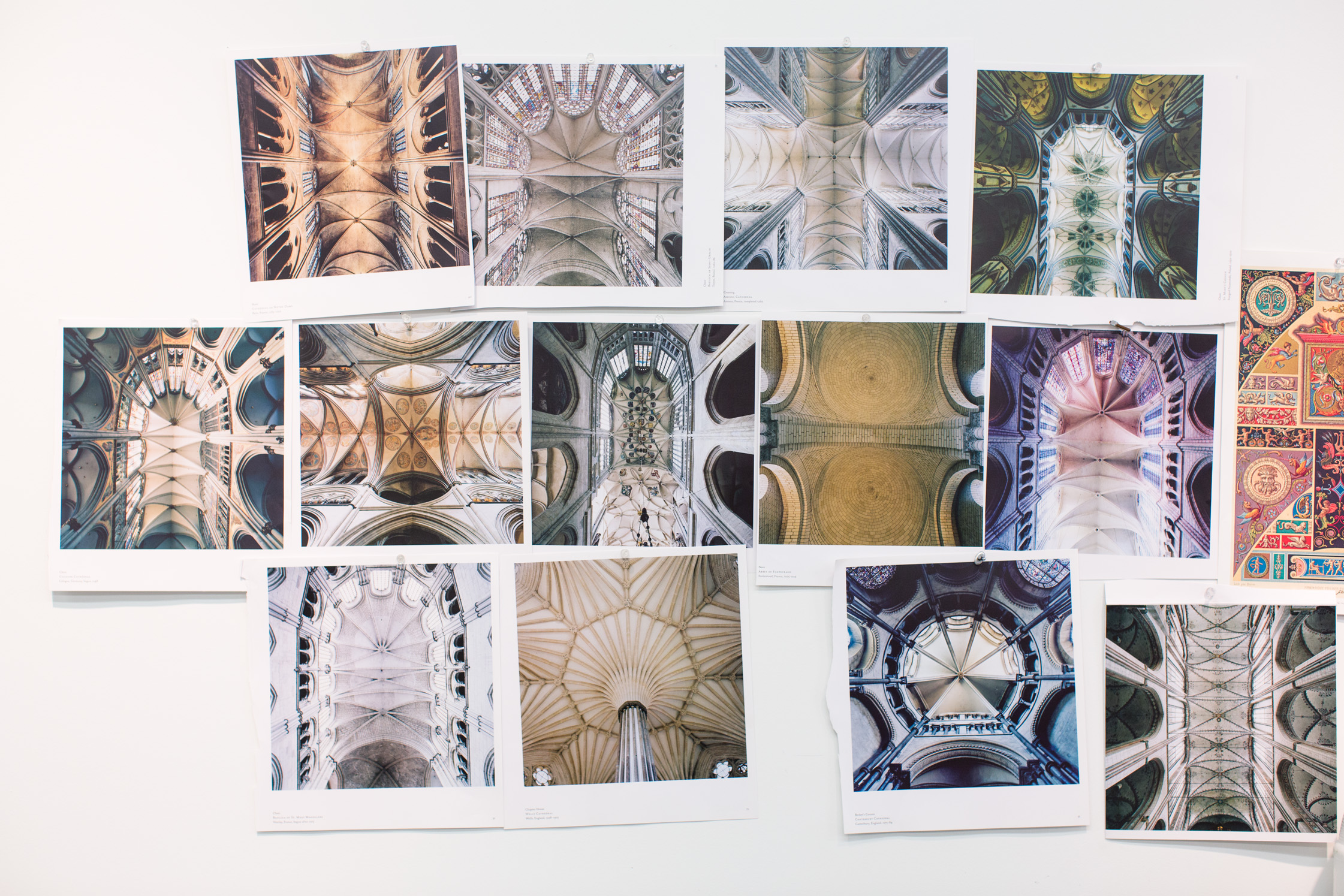

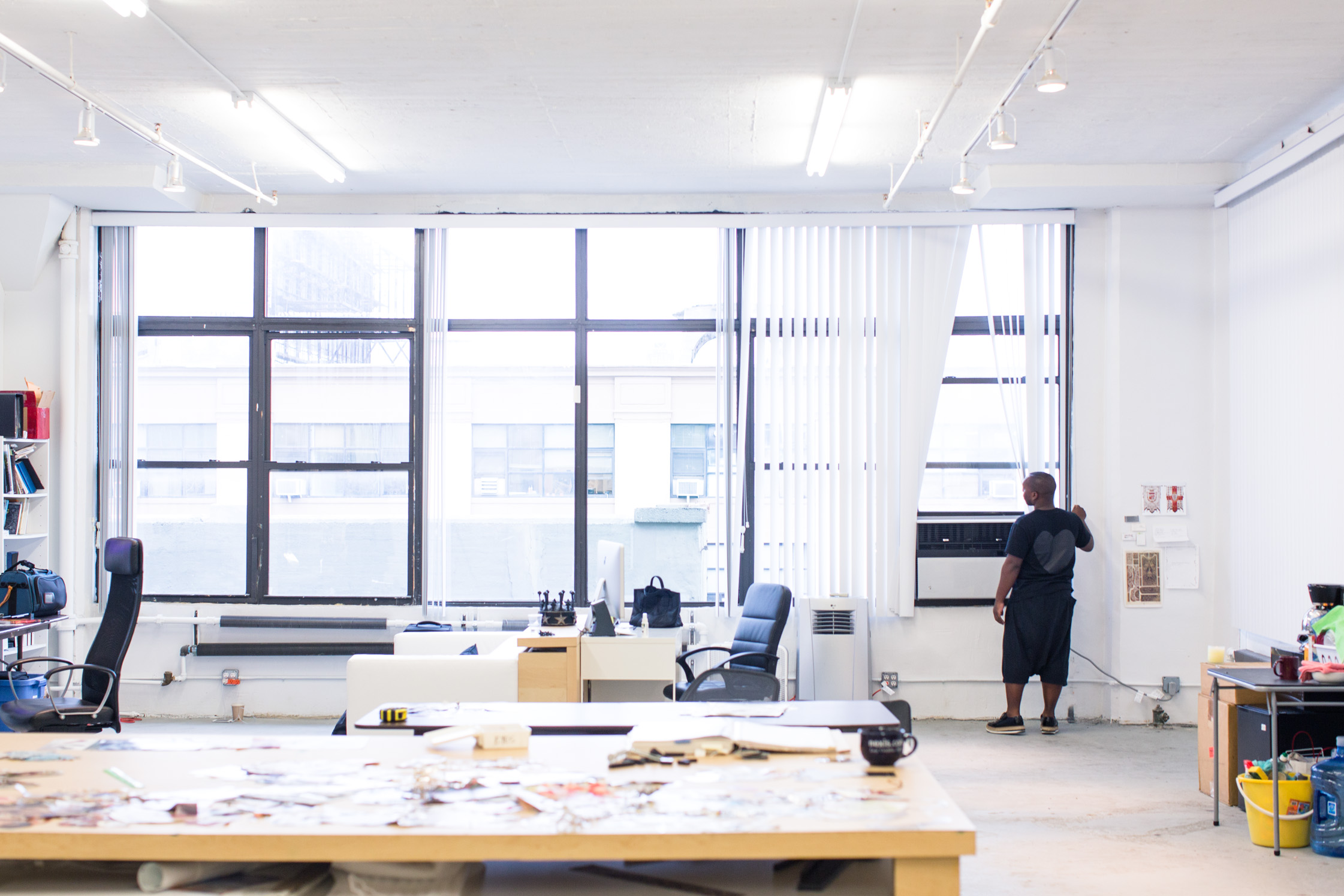




You have exhibited all over the world, from the Centre Pompidou in Paris, to Bolzano, and Moscow; what differences have you noticed between countries and their reaction to your Shade Compositions performance?
I haven’t noticed a particularly big difference in terms of how it is perceived, and I think that is because I feel like there is a universal component to my work. The work is very much like a marriage of subculture, which would be my culture, and art historical references ranging from architecture to aristocracy, heraldry, and ornamentation. All of these references have their beginnings as far back as the 16th century. It seems that people always understand it and they all have an entry point. Whether it’s from the pop culture side or the art historical reference.
Why do you think this is?
In a lot of ways, this understanding kind of proves how these things that seem to be isolated subcultures to me have now become a part of contemporary global culture. I say that specifically about work like Shade Compositions, because for instance, when I started the piece, I was thinking about gestural language in culture. It’s viewed as being something ‘ghetto’, used by people of the lower class, which is what made me want to work with it. It’s a language I use, the women I grew up around used, but then also in my travels I saw that it was something that wasn’t specific to that culture. Culture to me is something that is constantly in this state of flux. It lacks fixed boundaries, so at what point does this way of communicating lose the stigma of being ‘ghetto’ or of being used by the black middle class?
So to go back to your question about the Shade Compositions performance, the piece started with an original cast of all black females, and since then I have been restaging it. The whole idea of the piece is to go to a different environment, source the performers locally through a casting process, learn the gestural language of that place, and incorporate that into the choreography.
So the pieces are more site specific, since you are doing all of your casting locally?
Yes, so it varies from city to city. But because there is a string, brass, woodwind and percussion section, I try to bring one person from each section that has participated in a previous performance to accelerate the choreography. The one thing I found interesting is that when I go to a different place, the people cast for the piece don’t really know me and don’t really have a motivation, but when we go into the gestures, they will perform them eerily similar to the girls in New York!
So in some ways it reveals this truth that there is no longer ‘culturally specific material’. For instance, I did it in Moscow, and there was a girl in that performance who was so Banshee! She was moving like a black girl in Harlem, and who can tell her that it isn’t her identity? Identity is something that can be created at will.
Who is the ‘Conductor’? Is he a character?
Well for me, the conductor is not so much a character as much as it is a process. The conductor in the classical sense is someone who leads an orchestra and makes sure that people play in a linear fashion. So I apply that way of working or leading to my own practice. I guess when I think about my performance work, I started out in the pieces, even though the work was not about me being in the piece; it was about me creating something. So I became the ‘conductor’, if you will, of these rogue elements that became something else.
Many of your collage works use Adinkra symbols, what does West Africa mean to you and your work?
I have only used those symbols in one piece, but the work I make is very Eurocentric in nature. I started to think about places that didn’t participate in this history of heraldry and looked to places like Africa, Asia, and South America. I started with Africa. I started to think about the communicative symbols of that place. At the time I was really concerned with pattern and ornament, and the ornamentation of that part of the world would be Kente. I was looking at a lot of West African Kente, specifically from Ghana. I started with the background and recreated that with contemporary materials. Within the frame I wanted to bring in the symbols as well, which brought me to Adinkra symbols. It is a visual language that has been so under appreciated. I started to introduce some of my own ideals. I chose the symbol for wisdom, because that is something that I am constantly seeking, and the symbol for change. I want the work to constantly change and evolve. It’s all very important to me.
You mentioned ‘evolution’, with your work encompassing performance, video, collage and sculpture. How do you make sure they are ‘evolving’ together?
Just by working on them all at once. You know it’s kind of a funny question. I don’t know how to answer it because I often start with a project that will then have legs. These projects are not really specific to a medium when I start them; they are just an idea. Through the process of making that project, I have to learn how to use different materials and that is what is really interesting for me. I feel like a lot of my work is concerned with the practice of ‘making’, even though there is a final object. For me, the most exciting part is getting from point A to point B. And I think that is more evident in the performance work, because the role I take in the performance work is like the conductor, so you see me making the piece.
So it’s more a form of active making…
Yeah, so it’s really just by working on a little bit of everything at once and learning a new tool. Then realizing one tool might help me with another project, which then shifts everything that is happening into another direction and so on and so forth. So it’s very organic the way they work together. And I guess from a more practical standpoint, what makes the work more cohesive is my training. I have studied art history, I worked as a DJ, and I studied programming and music production, so they all sort of find their way into the practice.
Technology plays a major role in your performance pieces. How would you describe the influence your time at Harvestworks has on your work?
Well the collage work is very related to my training in digital music. The layering and pulling together to make one complete sonic experience, which is the same thing in film and video, creating a narrative experience by pulling together pieces. One could say it even extends to my collage work, which uses the process of sampling, and is specific to the way I was trained to make digital music. Everything is made up of sounds that are manipulated or pieced together to make one complete sonic experience. It’s the same thing with the film and video; I’m using clips to make a narrative.
My time at Harvestworks represents a huge shift in my work. For instance, with Shade Compositions, which I started when I was doing a residency in Paris, I went there because I had this free space to live, but I was actually traveling to different parts of the world and doing my own ethnographic research on the black female vernacular. So I ended up using the space as sort of a satellite studio, where I would cast women there, and they would stand against the wall and repeat these gestures. That turned into the performance.
This was without a technological element.
Exactly, and when I got back to NY I edited them into this sort of video quartet. But I didn’t want to continue what Christian Marclay had done, I wanted to do what I was doing and post live. Thankfully, at that time, I was at Harvestworks and was learning about Max/MSP Jitter programming. So I taught myself that. The Wii had just come out – which is a Bluetooth device – so I was free to move around. Everything just came together at the right time, so I could write code to make the Wii function as a guitar effect for the performance. It enabled me to do what I was doing, but post live.
I remember reading that you had written code for each of the buttons for different functions, and was so impressed that you were using such savvy technology in your work.
Yeah, Harvestworks really opened up that world for me. I didn’t really know about that particular programming language before then. It’s kind of endless in terms of what you can do with that language once you learn it. It can go as far as your mind can push it. It changed all of my performance pieces, and even pushed me to learn new code, which I used for the Five performance I did at the Whitney Biennial.
I wrote a patch for that which tracks the movement of color in real time. So during the performance, each dancer moves, but only using one of the elements that makes up the Vogue Femme. As they danced, I tracked different parts of their bodies and made drawings of them live. So once they hit the stage, which is a neutral space, they are asked to wear a specifically colored leotard so that I can track them. The movements that make up Vogue Femme are focused on different parts of the body, like hands, the catwalk, which is really in the hips, dip-spins, or the floor performance. I am actually writing new code now, so the drawings of their movements can be translated into 3D sculptures.
The Whitney Museum of American Art has long been criticized for being exclusive in the artists it chooses to exhibit, more specifically, for being an institution that under-represents women and people of color. Your piece forever changed ideas about The Whitney and made Voguing culture a part of art history. Were you aware of the impact your piece would have at the time?
Well, the way it happened was that I was developing the motion tracking patch I mentioned before, and when I got the visit with the curator I didn’t really have the concept for that performance sorted out yet, but I had an idea, and when they asked me to propose a performance, I knew that that was what I had to do. I looked at it as an opportunity to really perform in this institution and really show people what Voguing is, and I didn’t want to do it in an academic way. I wanted it to have some sort of artfulness. I wanted it to be abstract, because that really breaks down the history of Vogue performance within 30 minutes.
The piece does just that, but I also wanted to challenge the ephemeral nature of performance, which is why I created the patch. There is this whole notion that “performance is pure and it doesn’t produce anything”, but I’m an artist in the era of technology, so by standing on those people’s shoulders I embrace technology and see the power in performance.
And how was the work received?
I was told by the curators that it was the best performance they had seen there, which was great of course, but even better was the fact that none of the performers in my piece had ever even been to The Whitney before – and they are all from New York. That was crazy for me! So doing that piece was an opportunity to employ the community, because that community is underrepresented and could use some help. People always end up referencing that movie, Paris is Burning. Nobody in that movie was paid for being in it and the filmmakers are still making money today! It was about shining a spotlight on this part of performance history that has been otherwise overlooked and communicating that honestly. My performance was just the beginning of that conversation.
What was your first introduction to the Voguing scene?
It was in New Orleans, I went to a party and somebody was Voguing and I thought they were breaking, because vintage Voguing is very similar to breaking. So that was my first time seeing it in person, and then I saw Paris is Burning. Moving to New York I started to attend the balls and met some people who belonged to houses. I used to DJ at different parties and just got to know everyone in the community.
New Orleans introduced you to Voguing and is your hometown. I noticed the use of Fleur-de-lis in your collage work, a symbol also seen on the New Orleans flag.
Yes, it’s definitely homage to my hometown.
Your show at the New Orleans Museum of Art (NOMA) is titled King of Arms; I understand that it is a commentary on the fight for power and status consciousness that effects us all. When mixing ‘ghetto’ vernacular and European tradition, where do you find your inspiration for the imagery and materials used?
It’s funny because the show I just did came from my time in Paris as well. When I was working on the research for Shade Compositions, I still had that studio in Paris, so I started to make collages on the side. And what brought me to collage was looking at European architecture. Specifically things like wrought iron grills, which always have the coat of arms on the front. Researching those images and the history of them is what attracted me to them – the same things that attracted me to working with the black female vernacular. It’s how they both function as these open sources that people use to portray a position of power.
The NOMA show is part of The Great Hall Series, where people are invited to come to New Orleans and be inspired by and respond to the landscape. So I started to look at the city with new eyes. It wasn’t until I went back and started to work on the show that I realized it was so inspiring. For the procession I wanted to work with different communities that I found for the work. Specifically elements like the structure of a brass band, which gave birth to jazz. Sonically, the improvisation of jazz is really behind a lot of the underpinnings of my works Shade and Five. The pageantry and the ornament of the city and Mardi Gras culture is so evident in this work, and the whole idea of street theater and bringing that into the institution. There are performances everywhere in Louisiana.
Rashaad this yellow costume is fantastic.
This is actually a Mardi Gras Indian costume from the procession. They work on these for years. I looked to them for inspiration, just in the way they use their creative process to influence change in their community. A lot of the chiefs are healers in their communities, and when it started out they would get tips for healing and they would bring the money back to their community. I went there to have the show, but I also wanted to shoot the final video in the King of Arms Trilogy and use the museum as the setting.
It sounds like such a homecoming…
Yeah, I even got my own holiday! The mayor deemed June 21st ‘King of Arms Day’ in the state of Louisiana. I was hoping they would do the ‘Key to the City’ ceremony, with the big scissors and all that! But that whole process was really important to me. For the coronation ceremony I looked at a lot of coronations of kings around the world and also Mardi Gras king coronations. I started to look at a new performance history. New Orleans’ performance history really begins and ends in the streets. Even if you go far back, which is the Caribbean street and mass processional performance which made its way into Europe and even into Eastern Europe, and back to New Orleans.
I worked on that with an incredibly talented local high school band, and in a week we created the King of Arms song, and they were my musical component for the procession. I wanted the Mardi Gras Indians to lead the procession in these nearly 200 pound really ornate costumes, but they couldn’t really dance in the way I wanted them to. So I brought down a dancer and had a lighter suit made and had the dancer lead the Indians. They were really impressed with him and made him an honorary Indian. We also had to incorporate a float, because every procession needs a float! So I created this vinyl, which I wrapped around a Lamborghini Murciélago and then sprayed the rims in candy paint to match the vinyl.
Do you have a dream collaboration, living or dead, artist or institution, and why?
It would be really great to do a show at Versailles and the Louvre, in the context of my body of work. It would really be fantastic to work in various departments within those institutions. I’ve done it once on a smaller scale in New Orleans, in the French Portrait Gallery. One of my pieces called Herald was re-hung right across from a huge portrait of Marie Antoinette and Louis XIV, which makes for an interesting conversation.
Ultimately, what conversations do you want your work to spark?
I want to encourage conversation about the complexities of popular culture and the emerging global mainstream, and also how it’s languages of power are an institution that continues to be reshaped.
Rashaad thank you so much for allowing us to see inside your studio. To find out more visit Rashaad’s website here.
Photography: Alex John Beck
Interview & Text: Alyse Archer-Coite
